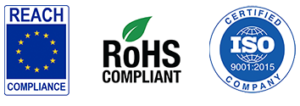When trying to determine the strength of epoxy it is important to know what type of strength you need. When reviewing data sheets, one can get inundated with different strength values. On the other hand may only give one kind of strength. It is valuable to know the differences in the given values as well as what is important to your application. When it comes to epoxy adhesives and potting compounds, there are several important strength values. These values include shear strength, compressive strength, flexural strength, and peel strength among others.
Shear Strength
Shear strength, with regard to epoxy adhesives, are common values used to portray the strength of epoxy. The most common of the shear strength values is lap shear strength. Lap shear strength is tested using ASTM method D1002. This method calls for a single lap joint bonded with an adhesive on standardized aluminum. This test allows for the lap shear strength of an epoxy standardized to aluminum. It is an excellent value to compare adhesives against each other.
Lap shear strength tested on etched aluminum. Strength is determined by the maximum load force needed to break the bond created by the adhesive. Because the bond area is 0.5in2, the load force is doubled to calculate the lap shear strength typically given in pounds per square inch (psi).
The lap shear strength test not only determines the strength of the epoxy but also the mode of failure is an important factor. There are two types of failure modes: adhesive failure and cohesive failure. Adhesive failure results in the adhesive completely losing its bond to the substrate. Adhesive failure results in one panel without adhesive and the other with the entire adhesive. With a cohesive failure, the strength of the adhesive itself is not as great as the forces applied to it and the adhesive pulls apart leaving portions of the adhesive bonded to both substrates.
Typical values of lap shear strength vary, however high strength can be considered a product with a lap shear strength of over 2500psi. High lap shear strength epoxy adhesives from Epoxyset include EB-260, EB-316M, EB-127TC, and EB-135.
Die shear strength is an important value in the semiconductor industry. It is used to determine the strength of a die bonded to a package substrate using a die attach adhesive. The die is subjected to a stress parallel to the substrate. This causes stress at the interface between the die and the die attach material. The force needed to break the bond is the die shear strength. A high die shear strength is >3400 psi (10 kg). Many of our semiconductor adhesives used in electronic assembly exhibit very high die shear strength. These products include our EO-24, EO-30M-1, and EB-470.
Compressive Strength of Epoxy
The compressive strength is the ability for the epoxy to handle weight. This test consists of applying force on the top and bottom of a cylinder of epoxy.
Compressive strength of an epoxy is important if the epoxy will be under heavy loads or under a high amount of weight. A typical compressive strength value for epoxies is about 10,000psi. Specially formulated epoxy materials, such as our EC-1850FT and EC-1850FT-LV, have compressive strength values of over 25,000psi. To put into perspective the compressive strength of the highest quality concrete is 5,000psi.
Flexural Strength
Flexural strength, also known as bend strength, is the material’s ability to resists deformation (or rapture) under a load. A bar of epoxy (or any material) is supported on the sides while a load pressure is applied to the middle. The amount of load the epoxy can withstand before fracture or deformation is the flexural strength.
Peel Strength
The peel strength of an adhesive is another type of strength of an adhesive bond. It is the average load per unit width of bond line required to part bonded materials where the angle of separation is 180 degrees and separation rate is 6 in/min. Generally very high peel strength adhesives have excellent bond to the substrates while having a lower modulus than most epoxy adhesives. A semi-flexible adhesive that bonds well tends to have the highest peel strength. This is because as the pressure is pulls substrates apart, the adhesive is flexible enough to withstand cracking.
Epoxyset has a number of high peel strength adhesives designed for high bond strength and crack resistance. These products include EB-260, EB-316M, EB-116, and EB-127TC. These toughened epoxy adhesives are used in a variety of applications for the electronics, medical, and industrial markets.





